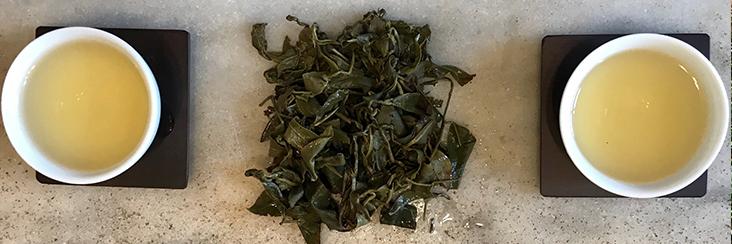
Leafhopper High Mountain Tea Tasting Notes | Eco-Cha Tea Club

The noticeably yellowish hue on many of the tightly rolled dried leaves shown above is a tell-tale indicator of the Green Leafhopper's presence during the growing season. Tea leaves that are bitten by the Leafhopper undergo a kind of oxidation while they are still growing. The tea tree's immune response to this minute scarring of the leaf is apparently what gives us the unique, robust complex flavor profile of what is simply called "Leafhopper Tea" in the local Taiwanese dialect.

The most commonly referred to trait in Leafhopper Tea is a honey-essence note in the fragrance as well as the flavor profile. This hint of honey varies greatly from batch to batch of "bug bitten tea", as it is also referred to locally. But the most general characteristic of this tea type is its bold complexity of aroma and flavor. It simply has a substance that clearly distinguishes it from a standard High Mountain Tea.
The constitution of bug-bitten leaves offers a challenge to the tea maker that varies from batch to batch. The leaves must be "read" much more carefully, and processed with an intuition that comes only from experience. This skill in processing these batch-specific leaves is as much of a claim to fame as the bug that is responsible for producing them. A successfully made batch of Leafhopper tea is well-balanced and particularly hearty in character. These leaves have significantly more brewing power along with their unique flavor profile. It is the hearty complex character that defines Leafhopper Tea.
 Less leaves can be used in brewing this tea as a result of its robust character. And when the brewing concentration is just right, a heady, rich full-flavored profile is attained. We are excited to share this unroasted batch of Leafhopper tea in order to allow Eco-Cha Tea Club members to experience its original character. We find it to be quite distinct from its relatives Oriental Beauty and Concubine tea in that there is a fresh, clean vibrant profile in these lesser processed leaves.
Less leaves can be used in brewing this tea as a result of its robust character. And when the brewing concentration is just right, a heady, rich full-flavored profile is attained. We are excited to share this unroasted batch of Leafhopper tea in order to allow Eco-Cha Tea Club members to experience its original character. We find it to be quite distinct from its relatives Oriental Beauty and Concubine tea in that there is a fresh, clean vibrant profile in these lesser processed leaves.

We look forward to hearing our Eco-Cha Tea Club members' experiences of this batch, along with any questions or reflections that may ensue from enjoying this unique tea type. Please post your comments, photos and videos here for all of us to learn from!

